
Nelson Hopper and wife, Earlene, at their home at the Big Valley Rancheria. Photo by Elizabeth Larson.
LAKE COUNTY – Nelson Hopper still remembers the war.
Some days, the 91-year-old World War II veteran says tears begin to run down his face, coming seemingly from nowhere. He said his war experience affects him a lot.
“I've seen some terrible things happen,” he said, which made him think differently about his life and the world.
Yet his recollections of the war aren't clouded by fear or sadness.
“I remember a lot of those things really clear. I can remember it still. It's never left my mind,” he said.
Born in February 1917, Hopper was raised on the Big Valley Rancheria.
On March 3, 1943, at age 26, Hopper was drafted into the US Army at the rank of private. He was shipped to Monterey and then to Camp Bowie, Texas, where he took his basic training, before being sent on to Fort Hood, Texas, to receive training as part of the 651st Tank Destroyer Battalion.
From there he was sent to Maryland and then put aboard the USS Marine Raven and sent to the European Theater.
He didn't make the Normandy Invasion; instead, he and fellow soldiers were sent to Scotland and then put on trains into England in May of 1944. A month later, they were sent by ship to Utah Beach in Franch. There, Hopper was placed in the Third Army, Fifth Division's infantry, under Gen. George Patton.
“I respected all those officers,” Hopper said of Patton and the other US war leaders. “They don't have them like that anymore.”
Hopper said he was afraid of dying in Europe, so far away from his home. He prayed every day and night, in his foxhole and as he went about his duties, asking to survive the war and get home safe. He said he promised to be a good person if he survived. “I live by that code, still.”
His grandmother called for a Big Head Dance to protect Hopper when he was first drafted, and another dance would be held after he was sent abroad.
While Hopper would survive the war to return to his family, they weren't left unscathed by the war. Hopper's uncle, Willie Holmes, died in Italy during the Battle of Anzio in January of 1944..
American Indians weren't segregated from other races in the Army during World War II, said Hopper, which is what happened to black soldiers.
Hopper became a squad leader, and said the men referred to him as “chief.” “I didn't mind that,” he said, adding that it was done in a friendly manner.
In fact, he said when many of his fellow soldiers discovered he was Indian, they treated him “like a king.”
During the terribly cold winter that began in late 1944, Hopper was in Germany, where he would shortly take part in the Battle of the Bulge.
He remembers an encounter with an elderly German man, who approached Hopper as he was burning wax paper from his K-rations to heat his coffee.
The German, who had gone to school in the United States, asked Hopper about his race, and Hopper replied he was an American Indian.
“This is not the Indian's war,” Hopper recalled the man saying. The man added that the US “took everything” from Indians.
Hopper said he told the man he was doing his duty and, when it was over, he looked forward to going home.
A short time later, in December of 1944, Hopper was wounded in the foot during the Battle of the Bulge.
Hopper said he didn't see many fellow American Indians while serving. However, it was a young American Indian medic who picked him up to take him to a field hospital after he was shot.
Not only was the medic Indian, he also was from the Lake County area. The medic's name was Bennett Elliott, who died at age 97 this past April. Hopper said Elliott would later remind him of their chance meeting, which Hopper said he hadn't initially recalled because he had been heavily medicated for pain.
Elliott took Hopper to a field hospital; from there, Hopper was sent to a hospital in Paris. During that time, he developed gangrene in his wounded foot and nearly lost his leg.
From Paris, Hopper was sent to a hospital in Birmingham, England, where he underwent spinal taps to deal with his swelling leg.
It would take him three months of hospitalization to recover, but even today he deals with the pain from that injury, which occasionally flares up in the form of pain and swelling.
In the spring of 1945, freshly released from the hospital, Hopper found himself once again headed back to France and then to Worms, Germany.
“By golly, the war ended while I was at Worms,” he said with a grin.
He found himself once again on the move, with the Army shipping him back to Marseilles, France. There, he was placed in the publications office. Hopper said he couldn't type and had no other publication-type skills initially, but they sent him to a 10-day school, where he learned to run a mimeograph machine.
But his service came to an end shortly afterward, as the war in Europe drew to a close.
“I feel, even to this day, that I had God on my side,” he said.
Placed aboard the hospital ship USS General Richardson, Hopper made his way home to the United States, landing in Boston after a 14-day sea crossing in a convoy of 74 ships, all of them zigzagging to avoid submarines.
“I was so happy to get back,” he said.
From Camp Miles Standish in Boston he was sent to Camp Beale in Marysville, where he was discharged. From there, he hitchhiked home to Lake County.
Initially, when he got home, Hopper said he didn't apply for disability due to his wounds. However, the Red Cross made application for him and he received a 10-percent disability determination. The Veterans Administration also did followup exams on his wounds in San Francisco.
He eventually went to work in Ukiah on the courthouse, and his foreman got him interested in becoming an ironworker, a job which took him to the Bay Area.
It was while climbing on a building project one day that he realized he was frightened of climbing, which hadn't happened to him before. That's when the Veterans Administration diagnosed him with what is known today as post traumatic stress disorder.
“'You have a problem and it's terrible,'” he recalled a VA doctor telling him.
“I still have it,” he added. “I'm scared even to this day.”
The same courage that took him through the war years went with him through the rest of his life. Hopper continued as an ironworker, eventually becoming a foreman and taking jobs around the state, including building underground missile silos at an Air Force base near Monterey.
He said he never let tough times get him down.
An opportunity came to go to South America for a dam project, but Hopper couldn't take his first wife with him, so he turned it down.
When he left the war behind, Hopper also left behind tokens of his service, in the form of his medals and awards, which he refused based on his Indian beliefs.
“We never do things to be praised for it,” he said. “We do it because it needs to be done.”
When he came home to Lake County, he joined the Joy Madeiros Veterans of Foreign Wars Post 2015. In 1986, the VFW post went to the US government – without Hopper's knowledge – to ask for the medals on Hopper's behalf.
During the Veterans Day ceremony on Nov. 11, 1986, decades after he had left the medals behind, Hopper got a surprise. He was called to the podium and presented with his awards and medals.
“I almost fell over,” he said.
He received that day the Bronze Star for Valor; a Purple Heart for the wound he suffered at the Battle of the Bulge; an Army Good Conduct Medal; the European-African-Middle Eastern Campaign Medal with four stars; the World War II Victory Medal; and the Combat Infantry Medal, which Hopper said he's proudest of, since it proves he was in combat.
Along with his medals, he received a letter from Superior Court Judge John J. Golden, congratulating him on his service.
This past May, an event was held to honor American Indian veterans, and Hopper was presented a flag and offered the event prayer. It was the first such occasion to specifically honor the contributions of American Indians to protect a country that is still very much theirs.
Today, Hopper has come full circle. He lives once again at Big Valley Rancheria with his wife, Earlene. The couple, married since 2000, live in a little house that looks out onto Clear Lake – or Xa-bahten, as it's known in the tribe's native language of Bahtssal, of which he's believed to be one of the last native speakers.
He has four children, two sons and two daughters, and numerous grandchildren, among them attorneys with Boalt School of Law degrees. His son, Joseph Myers, is executive director of the National Indian Justice Center, based in Santa Rosa.
Over the years, Hopper has taught young tribal members how to build tule boats and how to dance in and conduct ceremonies.
“I live here like I do because I'm an Indian,” he said. “I'm comfortable.”
While he jokes that he's been around “too damn long,” at 91 Hopper is still tall, active and optimistic.
“I'm shooting for 100, anyway,” he said.
E-mail Elizabeth Larson at This email address is being protected from spambots. You need JavaScript enabled to view it..
{mos_sb_discuss:2}

 How to resolve AdBlock issue?
How to resolve AdBlock issue? 



























